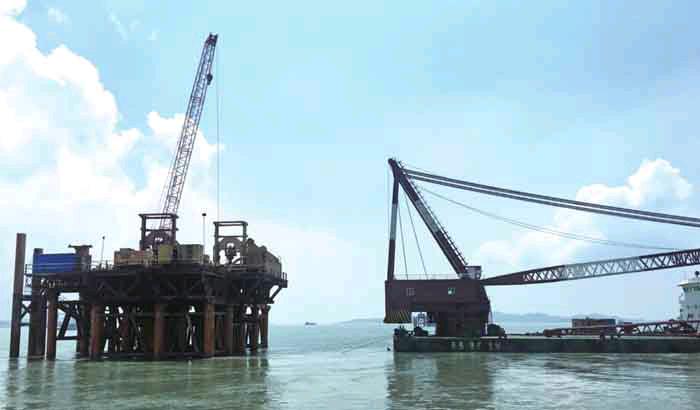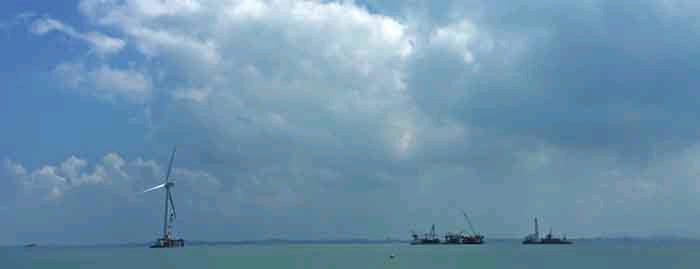Clean Energy on the Sea
2017-09-29ByDengYaqing
By+Deng+Yaqing
Against the foil of blue sky and boundless sea, a slice of pinwheel-like whiteness shines with metal luster under the blazing sun. Having withstood the recent typhoon Hato, the colossus—a 5-megawatt (MW) wind turbine independently developed by a Chinese company—now expects more of its breed coming from both home and abroad to settle down in Xinghua Bay, Fuqing, in southeast Chinas coastal Fujian Province.
Run by China Three Gorges Corp. (CTG), the Fuqing-based offshore wind farm will accommodate 14 high-power wind turbines, each boasting a generation capacity of at least 5 MW, manufactured by eight foreign players including General Electric and rising domestic players like Goldwind.
“After all the wind turbines are installed by the end of the year, a special challenge competition will be kickstarted among them. By tracking and assessing their technological reliability, quality, output and cost, CTG will join hands with the most excellent two or three producers to tap the abundant wind power resources in Fujian,” said Sun Qiang, executive director of CTGs Fujian energy investment branch.
As threats like climate change and rising sea levels loom, China is under pressure to find alternatives to power generation methods that cause pollution and discharge greenhouse gases.
“Offshore wind power is a viable option to gradually replace fossil fuel power,”said Lei Zengjuan, vice manager of CTGs Fujian energy investment branch, noting that offshore and onshore wind power can complement each other.
According to statistics from the Renewable Energy Policy Network for the 21st Century, wind power contributes 16 percent of the total power generated by renewable energy sources, second only to hydropower.
Compared with onshore wind farms, offshore ones in the same region usually generate 25 to 30 percent more power. Wind speed at sea is more stable, which results in less fl uctuation in the input to the power grid. And, most offshore wind farms in China are located close to high powerconsuming regions, so power transmission is not a problem. To top it all off, marine wind farms take up no land resources.
In 2016, the global installed capacity of offshore wind power generation facilities increased 18 percent to 2,219 MW. Britain, the largest offshore wind power generator, accounted for 36 percent of the worlds total installed capacity; and Germany, 29 percent. China, meanwhile, replaced Denmark by taking third place with 11 percent, according to statistics from the Global Wind Energy Council.endprint
Huge potential
With a coastline of around 18,000 km and an available sea area exceeding 3 million square km, China abounds in potential offshore wind energy resources. As the Chinese Government reiterates the significance of pursuing green, low-carbon development, the nation has made progress on this front in leaps and bounds.
According to the 13th Five-Year Plan(2016-20), by 2020, China will see 5,000 MW of installed offshore wind power capacity connected to the power grid and commencement of construction of an additional 10,000 MW of capacity.
“Fujian Province has the best offshore wind resource endowment in China, or even the whole of Asia, with utilization hours ranging from 3,500 to 5,500 annually, much superior to the average level of 2,000 hours registered by onshore wind farms in Inner Mongolia,” said Sun, noting that the Fujian Provincial Government plans to install 13,300 MW of offshore wind power capacity.
“CTG has received approval to build 4,100 MW of capacity, and another 1,600 MW is almost under our belt,” said Sun, who attributed the smooth progress to the local governments confi dence in CTGs strength in learning and innovating, which has been fully demonstrated by the companys successful development of large hydropower projects along the Yangtze River and the Jinsha River.
“Technology and capital are two major challenges that restrain the large-scale construction of offshore wind farms,” said Lei, noting that the company is committed to catching up with its foreign counterparts.
In October 2015, CTG reached an agreement with Portuguese power supplier Energias de Portugal to jointly invest 4 billion pounds ($5.17 billion) in developing the Moray offshore wind project in Scotland.
Last July, the company wrapped up a 650-million-euro ($771.42-million) deal in which it acquired 80 percent of the 288 MW Meerwind project, one of the largest offshore wind projects that have come into production in Germany.
“The manufacturers of the best-performing wind turbines in the Xinghua Bay wind farm will be chosen for inclusion in an offshore wind power industrial park run by CTG in Fuqing,” said Chen Yongming, leader of the industrial park project.
Chen explained that the industrial park is designed to introduce the most advanced technologies and gather all the links of the industrial chain in an effort to lower costs and pursue overseas expansion, which will benefi t humankind as a whole.endprint

“Now, the industrial park accommodates three wind turbine manufacturers, one blade maker, one steel structure manufacturer and related accessory factories. When completed in December 2019, it will be capable of producing annually wind turbines of at least 5 MW whose combined power generation capacity and production value amount to 1,500 MW and exceed 10 billion yuan ($1.52 billion), respectively,” said Chen.
Challenges ahead
According to a survey carried out by the State Grid Energy Research Institute, the average cost of offshore wind projects—$2,400 per kilowatt in 2015—is as much as 2.8 times that of onshore ones.
Another survey carried out by Bloomberg New Energy Finance showed that most offshore wind power projects in China generate electricity for sale at costs ranging from $0.16 per kilowatt hour to $0.23 per kilowatt hour, far higher than the prices of electricity produced by coal-fi red and onshore wind power.
“To fend off possible fi nancial risks, a project operator should fi nd a break-even point as soon as possible. And, only when a project generates profit is large-scale exploitation possible,”said Wang Qiang, marketing manager of CTGs Fujian energy investment branch.
While the environmental impact of such projects has raised concerns, Wang explained that people need not worry.
“Before a project commences, authoritative marine and ecological experts first engage in discussions to demonstrate the viability from the perspective of environmental preservation and produce an environmental impact assessment report. Without that, the project will never be put on track,” he said.
“Wind turbines standing in the sea have proven to be a positive infl uence, and actually some marine animals even use them as places to rest and gather,” said Wang.endprint
